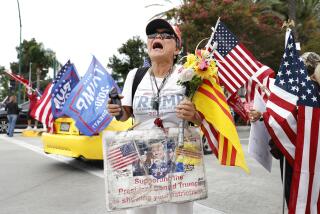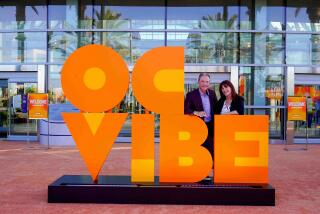W. ANDREW POPE : Shopping Centers: a New Look : Specialty Stores on Blueprints for Irvine Co. Expansion
- Share via
As the owner of one-sixth of the land in Orange County, the Irvine Co. is far and away the biggest force in the county’s continuing development.
Its holdings include roughly 2.5 million square feet of retail development. That number is expected to double to about 5.2 million square feet within the next five years.
The largest chunk of its retail property consists of small community shopping centers. But there’s also the Irvine Co.’s crown jewel--Newport Center/Fashion Island, the 1.1-million-square-foot regional mall that is one of the most exclusive in Orange County.
W. Andrew Pope is the man who oversees leasing, asset management and construction and design for the Irvine Co.’s retail division, called Irvine Retail Properties Co. At 45, his position as vice president of operations puts him in charge of almost 2 million square feet of retail projects worth more than $300 million.
A registered architect, Pope left his native Ohio to teach architecture at Alabama’s Tuskegee Institute. He eventually moved to Montgomery, where he started his own architectural firm.
Pope later joined Jim Wilson & Associates--a Montgomery developer with projects spanning 17 states--before being recruited by the Irvine Co. He signed on as senior director of retail in 1985 because the job would give him the chance to be a deal maker, putting together projects.
Since then, Pope has been involved in more than 30 retail projects, ranging from $1 million to $125 million in scope--and has earned a reputation in the industry as a shrewd, tough negotiator.
In a recent conversation with Times staff writer Mary Ann Galante, Pope talked about trends in the retail industry, where the Irvine Co. is headed and Orange County’s slow-growth movement.
Q. How has the competition changed among Orange County retailers?
A. It has become more intense for the merchants--although not so much for the shopping centers. But the merchants are dealing with a very sophisticated customer here. The department stores are probably in the most highly competitive market in the country. Up until recently the presidents of these companies have changed almost yearly, trying to compete for that business.
Q. What makes it so competitive?
A. There are more expendable dollars here. Irvine and Newport Beach both have some of the highest per capita incomes in the state, averaging about $60,000 per household. Those are tremendous numbers that are just unheard of.
Q. Where is the retail industry headed?
A. I think it’s becoming very specific. At one time, department stores were everything to everybody. I think you’ll find today that they’re becoming much more specialized in what they do. They’ve been out-competed on appliances. There are specialty stores like Circuit City and Federated who do it better. And that’s all they do. These markets are becoming much more niche markets with individualized, specialized type of stores that only sell one thing, sell a lot of it, sell it well--and offer really good service.
Q. What does the trend toward specialty stores mean in terms of what the Irvine Co. is doing?
A. I think that when we merchandise a center we have to handpick these stores so that we have the breadth and the depth that the consumer wants. We look first at the type of center that we’re doing--whether it’s a neighborhood center, a community center or a regional center--and then we determine goods and services and the type of incomes that we have. And we try to equate our (retail) businesses to that.
Q. What is the difference between neighborhood, community and regional centers?
A. Usually a neighborhood is a small center of about 100,000 square feet. It normally has a food store, probably a drugstore and then services such as hair salons and dry cleaners and some food. A community center is a little bit bigger. It would probably have some type of department store--like we have at our Crossroads Center (in Irvine)--which has Mervyn’s and Target. In size, we’re talking about 200,000 to 300,000 square feet. A strip center could be a community center or it could be a neighborhood center. And then the regionals probably have about 1 million square feet and up.
Q. Will the Irvine Co. continue to build smaller centers?
A. About every 5,000 homes will support a small service center. Then, as those homes accumulate, they’ll support a community center. The Irvine Co. builds about 5,000 homes a year, which dictates that we can almost build a center a year, in effect, just to support those homes. But we also didn’t have enough retailing establishments. And we saw much of our expendable income going out of our area to other centers.
Q. Would you say the same about regional centers?
A. I don’t think we’re over-malled because South Orange County hasn’t realized its potential yet. It’s not overbuilt, considering the number of homes (that the area) anticipates. South county can’t be over-malled because there are going to be a lot more homes built. Right now, it appears that well over 70,000 homes are at least pre-agreed to at this point, over the next five years.
Q. Two big competitors of Fashion Island are Main Place/Santa Ana and South Coast Plaza. How would you assess their performance?
A. South Coast and Main Place are probably some of the best malls built in the country. I don’t feel that Main Place affects us. We look at South Coast Plaza as complementing Fashion Island. There’s a lot of cross-shopping. At Fashion Island, what we’re trying to do is add some of the more moderate price points, so that people don’t have to drive all the way from Newport Beach to South Coast Plaza. Not everybody can afford to shop at Fashion Island. There are a number of stores that we brought in just recently--Casual Corner, Ports International, the Limited, the Limited Express. Those are all stores that we’re bringing in that are in the price range we’re talking about.
Q. Is it primarily to keep the customers coming back?
A. That’s one reason. Another reason is that those retailers are often on the forward edge of fashion. The Limited can bring in goods that are immediate at prices that sell quickly. They’re trendy. We don’t have enough of those, and we’re losing that kind of business.
Q. Would you eventually see, say, a Montgomery Ward store at Fashion Island?
A. Now you’re talking department stores. In department stores, I think we have a good mix. (J.W.) Robinson’s and the Broadway offer a good moderate price point. We had a JC Penney at Fashion Island and in its last year (1982-1983), it only did $5 million as a full-fledged department store. That shows that there wasn’t that type of need at Fashion Island.
Q. How about the (proposed) Irvine Center at the Golden Triangle area, the intersection of Interstates 5 and 405. When do you actually see it breaking ground there?
A. We’re still scheduled for breaking ground in 1989 or ’90. We still want to open it in either the fall of 1991 or spring of 1992.
Q. How much of that project is planned as retail?
A. With our agreement with the city of Irvine, we can put almost 1.8 million square feet of retail within the Golden Triangle area. Our current plans only call for about 1.5 million square feet of retail over the next 10 years.
Q. Do you have any idea yet who some of the tenants will be?
A. None at all. I think we’re in a holding pattern right now until Macy’s absorbs the new group of stores they bought in Southern California--which is Bullock’s--and until we select a joint venture partner.
Q. How likely is the possibility of adding a retailer like Harrods at the Golden Triangle?
A. We had discussed Harrods and we had evaluated their store. We felt that they would probably go to the East Coast first, where their merchandise is more applicable, because Harrods is merchandised like an English department store, with wools and tweeds. They’d be better in a seasonal climate like the East than in Southern California. It would be a whole new merchandising concept if they came here. Are they capable of it? I don’t know. But we thought it was risky.
Q. Were there plans to include R.H. Macy & Co. in the Golden Triangle?
A. Macy’s had selected a site to be one of our anchors there. Our site was one of two that they selected. The other one is in Los Angeles in Marina del Rey. We have been, in effect, put on hold by Macy, and we will not know for another couple months until we sit down with them. I think it was always our intent to try to go after Bullock’s as our third or fourth department store. Now that Bullock’s, in effect, is Macy’s, I think that we would still think there is a market for them in South Orange County.
Q. What about Robinson’s?
A. Robinson’s is May Company for all general purposes. (In late 1986, May Department Stores bought Associated Dry Goods, parent of J.W. Robinson.) That has eliminated all of the high end in all their stores. As a matter of fact, we saw a trend at Fashion Island where Neiman-Marcus’ sales jumped when they eliminated it.
Q. It seems inevitable that development will slow down in Orange County. Because of the traffic situation, it seems that there is going to be less inclination to issue building permits. Do you agree?
A. Yes. I think that building permits are just going to be harder to obtain. I think developers are going to have to work harder. We are going to have to give up more to get them. . . . It’s unfortunate because Orange County has an industry that people don’t recognize, and that is development. It’s a clean industry. It produces a good product, a well-planned product. Orange County is one of the most obviously well-planned areas to live within the country.
When you look at the long-range program in California, there’s very little money spent on roads today. It has been two decades of very slow progress in any type of road building or state assistance. And that’s what it’s going to take. It can’t be put on the developers’ backs. What is needed is tax dollars to build the better roads, maybe a higher tax on the gasoline that would go to roads. It will take more innovative ways of creating roads.
Q. But that’s really a long-term solution. What does Orange County do in the short term?
A. I think there will be some short-term programs. There will be some roads built by developers. There will be people who will move closer to work. There will be the slow growth.
Q. Do you see that coming in?
A. Yes. We’re anticipating it.
Q. Is the Irvine Co. rethinking its options? Are you scaling back?
A. I don’t know that we’re scaling back at all. We are rethinking our options, and I don’t think that we’re looking at the next five years, I think we’re looking at the next 20 years and what it means to us. Stopping growth is not going to improve the traffic that we now have today. It just won’t work that way. It’s going to take more roads, it’s going to take more sophisticated transportation systems.
Q. You’ve mentioned the Irvine Co.’s planned development, Irvine Center, in the Golden Triangle area. How will it be affected by South Coast Plaza?
A. The Irvine Center is eight miles away from South Coast Plaza and really serves its own market area. All the traffic that comes from south county going to South Coast Plaza will have to pass by Irvine Center. Today, based on our marketing reports, we know we could put over 1 million square feet of retail development in an enclosed mall in that area.
Q. What about the potential traffic congestion in that area?
A. That’s well-planned. You’re not looking at (Interstate) 5 and the 405. You’re looking at three major arterial roads that go through there--Barranca, Alton and Irvine Center that have a capacity of 50,000 cars a day. So surface roads are well-planned.
Q. From a retail standpoint, what else would you like to see more of in Orange County?
A. I think entertainment spots. With our property we’re looking at probably doing some more nightclubs; we’ll have more bars. Our Improv has been a wild success at Market Place, Irvine. It’s booked every night.
Q. What about the concept of shopping as entertainment?
A. I think it is entertainment. That’s the way people entertain themselves today. They take their expendable money, and just like they go to the show, they go to the department store. They look, they shop, it’s a sensual thing. They look at what’s coming up in trends, in fashions, and then they buy. And along with buying merchandise they also entertain themselves with food along the way. They browse. We want them to stay in the center. Our whole idea at Fashion Island is to try to keep them that extra hour. Let them just sit in the center and watch people. We want to focus, obviously, on shopping, but food (also) and then having Fashion Island serve as the downtown for Newport Beach.
More to Read
Inside the business of entertainment
The Wide Shot brings you news, analysis and insights on everything from streaming wars to production — and what it all means for the future.
You may occasionally receive promotional content from the Los Angeles Times.










